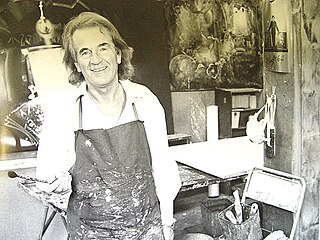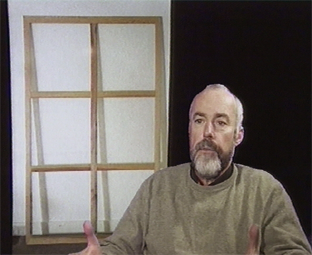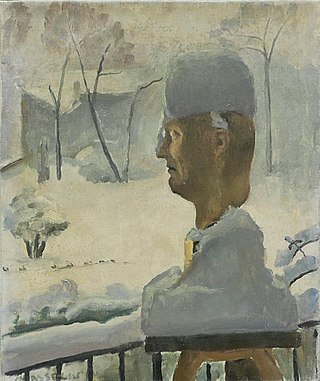Related Research Articles

Ivan Albertovich Puni was a Russian avant-garde and French artist, who intensively changed his style until it went into lyric Primitivism in the direction of Pierre Bonnard and Edouard Vuillard.

Georges Papazoff was a Bulgarian painter and writer. He became prominent in Paris, worked and died in France. He was among the first surrealists, and was an acquaintance of Joan Miró, Max Ernst and Pablo Picasso.

Árpád Szenes was a Hungarian-Jewish abstract painter who worked in France.
Mario Prassinos was a French modernist painter, printmaker, illustrator, stage designer, and writer of Greek-Italian descent.

Jean René Bazaine was a French painter, designer of stained glass windows and writer. He was the great great grandson of the English Court portraitist Sir George Hayter.
Jean Fautrier was a French painter, illustrator, printmaker, and sculptor. He was one of the most important practitioners of Tachisme.

Augustin François Guille, called Archiguille was a French painter.
Gaston Diehl was a French professor of art history and an art critic.

Daniel Dezeuze is a French artist and a founding member of the French group of artists called Supports/Surfaces. This group started to form in 1966. Their common concern was a desire to deconstruct painting in order to re-examine its history and question its nature. Colour is a fundamental question in many of their works. They frequently used non-traditional materials and referred to other non-western cultures.

Berthe Weill was a French art dealer who played a vital role in the creation of the market for twentieth-century art with the manifestation of the Parisian Avant-Garde. Although she is much less known than her well-established competitors like Ambroise Vollard, Daniel-Henry Kahnweiler and Paul Rosenberg, she may be credited with producing the first sales in Paris for Pablo Picasso and Henri Matisse and with providing Amedeo Modigliani with the only solo exhibition in his lifetime.

Jean Messagier was a French painter, sculptor, printmaker and poet. Jean Messagier had his first solo exhibition in Paris at Galerie Arc-en-Ciel in 1947. From 1945 to 1949 the artist worked under the influence of Pablo Picasso, André Masson, Paul Klee and François Desnoyer, his professor at École nationale supérieure des arts décoratifs in Paris. Messagier again was revealed to the public at an exhibition organized by Charles Estienne at the Galerie de Babylone in 1952, entitled "La Nouvelle École de Paris". The following year, Messagier deliberately broke away from his expressionistic form of Post-Cubism; his inspirations now focused on Jean Fautrier and Pierre Tal-Coat to develop a personal vision in which he renders "light...approached abstractly." Jean Messagier is often associated with Lyrical abstraction, Tachisme, Nuagisme, Art informel and paysagisme abstrait, though the artist himself had never accepted any labels, and had always refused the distinction between abstraction and figuration. From 1962 until the year of his death Jean Messagier exhibited in France and abroad, taking part in some major international events as a representative of new trends in French painting.
Simon Joseph Simon-Auguste was a French artist, known for his intimate paintings, mainly portraits, nudes and still lifes. His production is characterized by a calm, intimate feel, and the effective use of glaze.
The Galerie Barbazanges was an art gallery in Paris that exhibited contemporary art between 1911 and 1928. The building was owned by a wealthy fashion designer, Paul Poiret, and the gallery was used for Poiret's "Salon d'Antin" exhibitions. The gallery showed the work of avant-garde artists such as Picasso, Modigliani, Gauguin, Matisse, Chagall, and Dufy.
Jacques Grinberg (Yaacov Grinberg was a Neo-expressionist painter and printmaker.

Michel Ragon was a French art and literature critic and writer. His primary focus was on anarchic and libertarian literature.

Hocine Ziani is an Algerian painter and artist in plastic arts.
Greta Saur (Sauer) was a German painter who lived and worked in Paris. She was an abstract painter, specifically in the style of lyrical abstraction of the "Nouvelle Ecole de Paris".

Jean Degottex was a French abstract painter, known in particular for his initial proximity with the lyrical abstraction movement of the 1950s and 1960s. He is considered an important artist of the abstraction movement in the second half of the twentieth century and a significant inspiration for contemporary art. Degottex was particularly inspired by East Asian calligraphy and Zen philosophy in achieving the erasure of the creative subject.
Pierre Loeb was a French art dealer and gallery owner who focused primarily on Surrealism and 20th-century Modernism. In 1924 he founded the Galerie Pierre in Paris, whose most famous exhibition was the first collective exhibition of Surrealists the following year.

Maurice Paul Jean Asselin was a French painter, watercolourist, printmaker, lithographer, engraver and illustrator, associated with the School of Paris. He is best known for still lifes and nudes. Other recurring themes in his work are motherhood, and the landscapes and seascapes of Brittany. He also worked as a book illustrator, particularly in the 1920s. His personal style was characterised by subdued colours, sensitive brushwork and a strong sense of composition and design.
References
- 1 2 "Un américain à Paris, Paul Crotto · MNA". mna.fnagp.fr (in French). Archived from the original on 2016-06-05. Retrieved 2017-09-19.
- ↑ King, Bruce (2017-04-25). Interesting Life, So Far: Memoirs of Literary and Musical Peregrinations. Columbia University Press. ISBN 9783838269566. Archived from the original on 2018-04-26. Retrieved 2017-09-30.
- ↑ "ZAK'S GALLERY OF DEIA FACES". www.zakstudios.net. Archived from the original on 2013-12-10. Retrieved 2017-09-30.
- 1 2 Crotto, Paul (1962). Crotto: Galerie Jeanne Castel, Paris, du 15 au 30 novembre 1962 (in French). La Galerie. Archived from the original on 2018-04-29. Retrieved 2017-09-19.
- ↑ "Original oil on canvas by Paul Crotto ( American) - Oil Paintings". Brownrigg Antiques. Archived from the original on 2018-04-29. Retrieved 2017-09-28.
- ↑ EHRMANN, Thierry. "biographie de Paul CROTTO: informations et ventes aux enchères des oeuvres de l'artiste Paul CROTTO - Artprice.com". fr.artprice.com (in French). Retrieved 2017-09-28.
- ↑ Ehrenmark, Torsten. An American artist in Sweden/ Amerikansk parisare pa Blanche (Dagens Nyheter, 11 May 1963)
- ↑ Mourges, Pierre. Paul Crotto - Prix de Peinture de Villeneuve 1963, (Théâtre Georges-Leygues, 15 Septembre, 1963)
- ↑ Deux maîtres: Paul Guth (l'écrivan) at Paul Crotto (le peintre), (La Dépêche du Midi, 16/7, 1963)
- ↑ M. Seurière, Crotto, Densité (Arts, 9 Nov. 1964)
- ↑ ArtFacts.net. "Paul Crotto". ArtFacts.net. Archived from the original on 2018-04-30. Retrieved 2017-09-28.
- ↑ Froche, Michel. (Lettres Françaises, Nov. 1964)
- ↑ Gauthier, Maximilien. (Les Nouvelles Litteraires, 12 Nov. 1964)
- ↑ Blasco, Alec M. American artist in Paris, (Los Angeles Herald Examiner, 1968)
- ↑ "Crotto | S Cohen Fine Art". scohenfineart.com. Archived from the original on 2017-05-21. Retrieved 2017-09-28.
- ↑ J.D, Aux Ecoutes, No 2273, 7–23 February 1968
- ↑ Kreisberg, Louisa. Gallery Offers One-Man Show (The Reporter Dispatch, White Plains, N.Y.,24 May 1969)
- ↑ Werther, Betty. Art (Time-Life, Paris, 1969)
- ↑ Cabanne, Pierre. Sculptures des Peintres catalogue, Galerie Roger Le Grall, 18 May - 30 June 1967, Paris